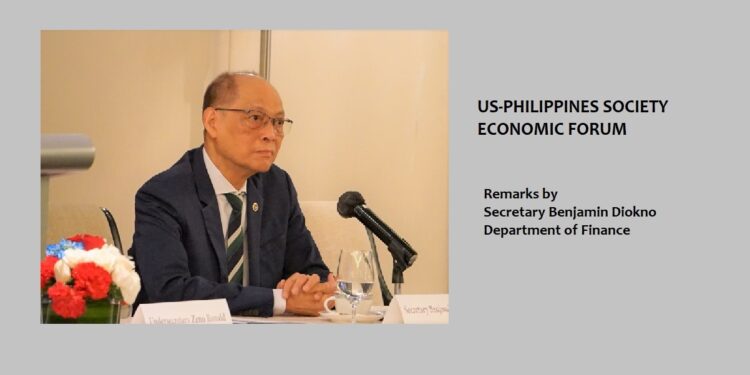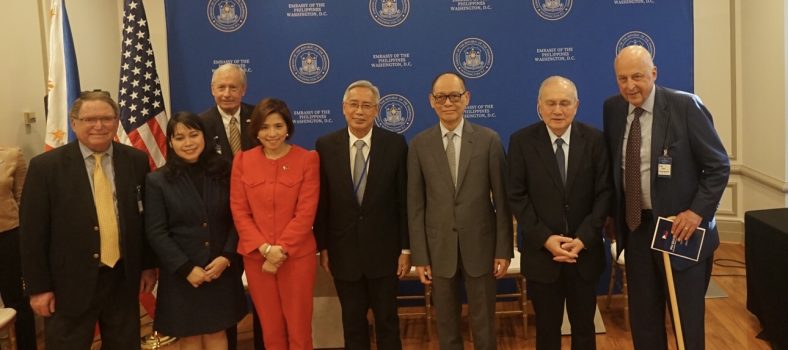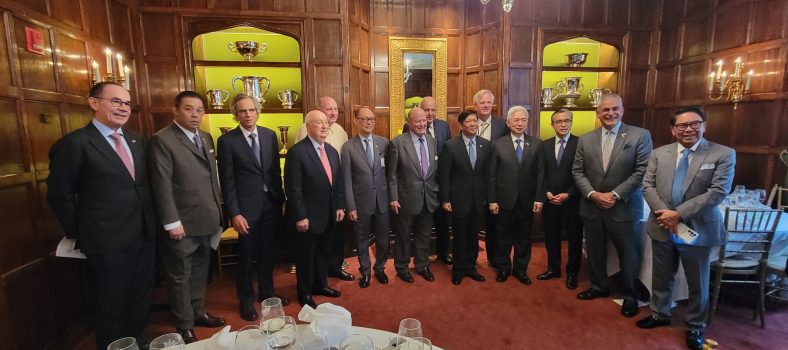Economic Policy Forum Remarks by Secretary Benjamin Diokno
US-Philippines Society
Economic Policy Forum
Remarks by
Benjamin E. Diokno
Secretary of Finance
January 31, 2023
Good morning, everyone.
The Philippines has long enjoyed strong diplomatic relations and fruitful economic partnership with the US.
In the last six years, the US has been the Philippines’ third largest trading partner and the fourth top source of foreign direct investments. The US is also the Philippines’ biggest source of overseas Filipino remittances.
As economies emerge from the pandemic, stronger international cooperation presents itself as the quickest path to recovery and shared prosperity.
In a global economy beset with low growth and high inflation, we need a much stronger trade engine.
And the Philippines is proud to be part of the Indo-Pacific Economic Framework for Prosperity along with the US and 12 other countries in the region.
Together, the 14 IPEF partners represent 40 percent of the global GDP and 28 percent of global goods and services trade.
IPEF strengthens the culture of cooperation. It enhances economic stability while offering tangible benefits that fuel economic activity and investment, promote sustainable and inclusive economic growth, and benefit workers and consumers across the region.
The Philippines is eager to share its promising economic future with the rest of the world.
Our strong macroeconomic fundamentals and structural reforms have enabled the Philippine economy to weather the effects of the pandemic and position itself as one of the fastest-rising economies in the Asia Pacific region.
Just a few days ago, we announced that in the fourth quarter of last year, the Philippine economy grew by 7.2 percent, bringing our full-year GDP growth rate to 7.6 percent. This surpasses our own full-year target of 6.5 to 7.5 percent.
Our strong economy reflected robust domestic demand driven by household consumption and investments.
This dramatic recovery was the result of deliberate, well-crafted structural reforms and the resolve of the Philippine government to recalibrate policies as needed.
To guide our growth trajectory, the Marcos administration has crafted a credible policy framework anchored on the twin goals of economic and social transformation.
We have put together a comprehensive socioeconomic agenda covering the next five years to tackle immediate concerns while remaining supportive of long-term growth.
This 8-point socioeconomic agenda serves as the basis for the Philippine Development Plan 2023 to 2028.
Fiscal discipline will be critical in this endeavor. As such, we have developed the Philippines’ first-ever Medium-Term Fiscal Framework. On its first session day, the President submitted the Framework to Congress, which Congress quickly approved.
The Framework outlines our fiscal strategy to bring down the debt-to-GDP ratio to less than 60 percent by 2025, reduce the deficit-to-GDP ratio to 3.0 percent by 2028, and maintain high investment rate in infrastructure at 5 to 6 percent of GDP annually.
These lofty economic goals are supported by structural reforms that remove barriers to foreign investments, further open economic sectors to foreign equity, improve the ease of doing business, and allow for modern, transformative industries to take root and grow.
For one, and this should be of interest to you, we have opened up the renewable energy sector to full foreign ownership, particularly in the exploration, development, and utilization of solar, wind, hydro, and tidal energy.
We are likewise tapping into the many benefits of public-private partnerships to support the massive infrastructure program of the Marcos administration.
Within the President’s first 100 days, we amended the implementing rules and regulations of the Build-Operate-Transfer law to better leverage PPPs to boost the competitiveness of domestic industries and attract a diverse range of investment opportunities.
On this front, the Philippines and the US remain committed to cooperate on high-quality, private sector-led infrastructure investment as a means of supporting economic growth and enhancing connectivity in the Philippines.
We are also vigorously pushing for digitalization to transform Philippine agriculture into a dynamic, high-growth sector. With the US being one of the world’s major food producers, we see immense potential benefit in having American investments in this area.
On the other hand, the Philippines intends to harness the potential of the extractive sector to drive long-term economic expansion.
We believe that the mining industry has the greatest potential to be a key driver of our recovery and development, especially now that world metal prices are high. The Philippines, after all, is one of the world’s most richly endowed countries in terms of mineral resources.
Manufacturing is another key area of cooperation. This is a good time for US firms that are looking to diversify their supply chains to see the Philippines as a viable source of intermediate products and services.
The semiconductor and electronics industry is the top contributor to the Philippines’ manufacturing sector and it represents our largest export sector. Looking ahead, we expect demand to expand in the next 12 months.
We look forward to enhancing collaboration on supply chains, including semiconductors and green metals processing through mobilizing investments, technology transfer or adaptation, capacity building, and complementation of value chains.
And while some of our closest neighbors are grappling with aging populations, the Philippines has a very young and skilled workforce, with a median age of 24. There is great talent in our market ready to be unleashed.
Now more than ever, economies must intensify collaboration as the world tackles what is now being called a ‘polycrisis.’
Now rest assured that the Philippines stands ready to broaden dialogue and deepen cooperation through the Indo-Pacific Economic Framework and Asia-Pacific Economic Cooperation.
We look forward to working with you all.
Thank you very much.



